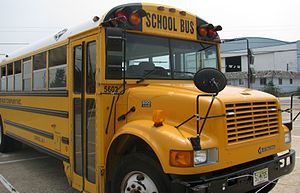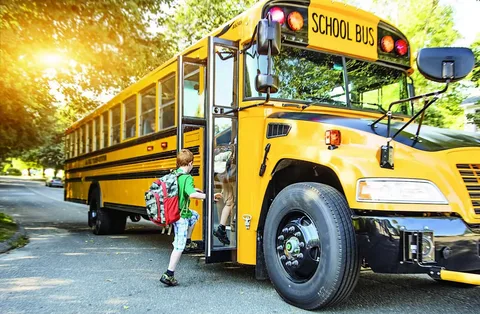Carpenter Body
Table of Contents
Foundation
1950s-1980: Reconstruction and Expansion
Throughout the next twenty years, the business prospered and Carpenter became one of the “big six” major school bus body builders in the United States, competing directly against Blue Bird, Superior, Thomas, Ward, and Wayne.
1980s-1995: Bankruptcy and Dr. Beurt SerVaas
In the early 1980s, there was a decline in U.S. public school enrollments as the baby boom generation finished their education and became older than school age; correspondingly, demand for school buses in the United States declined, a situation compounded by overcapacity in the bus body industry and the unstable economy. The company unsuccessfully attempted to diversify into the small transit bus market. By mid-decade, Carpenter had entered into Chapter 11 bankruptcy. Salvation came to the company in the form of an Indianapolis-based industrialist, Dr. Beurt SerVaas, who led a refinancing and revitalization program to attempt to restore the role of Carpenter in the national school bus market. Major concessions came from the labor force and production of school buses continued.
During the 1980s, Carpenter would also make major updates to its product lineup. Carpenter’s conventional-style school bus (the Classic) underwent body revisions in 1984 and 1986. While the Cadet Type B was one of the first small school buses (introduced in 1969), it was not until mid-decade that the company developed a Type A school bus (the Classmate), last among major manufacturers. The Corsair transit-style school bus, in production since the 1960s, was retired and replaced with the Cavalier. In 1991, the Cavalier was replaced by the Counselor FE and the Coach RE; the latter marked the beginning of the relationship of Carpenter with Spartan Motors.
Crown Coach acquisition
In May 1991, Carpenter purchased the tooling and product rights of Crown Coach, a California-based manufacturer that had closed its doors two months prior. The original intent of the company was to restart production of the Crown Supercoach Series II under the Carpenter name, but the complexity of its design proved too expensive for mass production. However, a few of the Supercoach Series II’s styling elements would influence the final design of the replacement for the rear-engine Corsair: the Carpenter Coach RE.
1996-1999: Crown By Carpenter
In 1996, Carpenter leased the former Wayne plant at Richmond, Indiana, relocating from its aged facilities in Mitchell. During this transition, Carpenter revised the body design of all of its buses; the changes included:
- Changes to rubrail mounting on exterior
- New roof design, utilizing one-piece roof bows
- Redesigned driver control panel (based on Wayne Lifeguard)
- New windshield (from Wayne Lifeguard)
- New service door (from Wayne Lifeguard)
- Carpenter “Counselor” FE/RE Type D re-branded as Crown FE/RE
At the new location, Carpenter had the advantage of an experienced team. Both the leadership and workforce based at Richmond included a number of veterans of the former Wayne operations. As such, they brought considerable experience and knowledge of the plant and industry to the effort. In adapting to the equipment at the Richmond plant, a change to the techniques of welding the roof joints from the procedures used before at Mitchell would later prove vital in excluding Crown by Carpenter products from containing a crucial structural flaw. But that situation was not envisioned by anyone then and would only become an issue many years in the future.
One innovation that Carpenter introduced during this period was a change to the design of its “Crown RE”, mounted on a Spartan Motors chassis. The Crown RE was the first rear-engine school bus to feature an option of a conventional rear emergency door instead of an emergency exit window typical on rear-engine school buses. To make this possible, the floor was slanted up in the last few rows in order to gain height over the engine compartment. Crown by Carpenter also produced a delivery truck loosely derived from its “Cadet” Type B school bus line.
In 1998, Carpenter was sold to Spartan Motors, a Michigan-based manufacturer of chassis for fire apparatus and high-end recreational vehicles. Starting in the early 1990s with the Coach RE, Spartan had gained entry into the school bus industry through Carpenter; a prototype built for Wayne Wheeled Vehicles never saw production. Nevertheless, major outside forces still to be faced were a supply of suitable chassis and the overcapacity of the body industry.
1999-2001: Return to the Carpenter Name
Closure
(Thanks to Wikipedia for allowing the use of company history)


1991 Carpenter on Chevy Chassis.

Conventional from Manitowoc, Wisconsin.

Conventional drivers area, Ford based chassis.

1986 Conventional from Lasalle Parrish.

Toledo City 1991 conventional.

1993 Ford Chassis mini bus from Washington Local.

A pair of 93 Transit Style Buses, known as Counselor.

Ledgemere transit has this early 90’s unit.
Jupiter bus is the proud owner of this 1990 conventional.

90 Counselor on GMC Chassis.

1971 conventional from New Jersey.

Portage County, Ohio has this 1995 conventional.

2001 conventional.

Oxnard schools has this Carpenter from 1997.
1993 Front engine transit.

1985 conventional from Greenfield, OH.

Older Counselor RE from California.

Perry Twp, Ohio has this 1995 Conventional.

Another 95 from Perry Twp.
More to Come!










